Intel's Pentium M on the Desktop - A Viable Alternative?
by Anand Lal Shimpi on February 7, 2005 4:00 PM EST- Posted in
- CPUs
Workstation Applications
Visual Studio 6
Carried over from our previous CPU reviews, we continue to use Visual Studio 6 for a quick compile test. We are still using the Quake 3 source code as our test and measure compile time in seconds.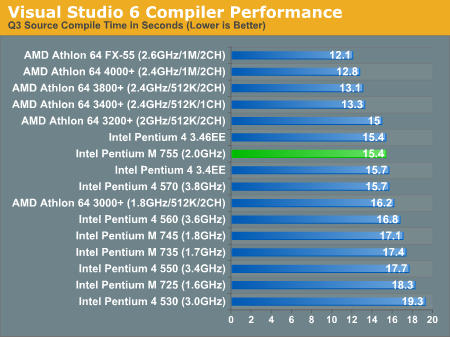
The Pentium M is very competitive with the Pentium 4 in our compiler test, but still not enough to compete with the Athlon 64.
SPECviewperf 8
For our next set of professional application benchmarks, we turn to SPECviewperf 8. SPECviewperf is a collection of application traces taken from some of the most popular professional applications, and compiled together in a single set of benchmarks used to estimate performance in the various applications that the benchmark is used to model. With version 8, SPEC has significantly improved the quality of the benchmark, making it even more of a real world indicator of performance.We have included SPEC's official description of each one of the 8 tests in the suite.
As you can guess, with the majority of performance in 3D workstation applications being determined by floating point performance and memory bandwidth, the Pentium M doesn't fare too well:
3dsmax Viewset (3dsmax-03)
"The 3dsmax-03 viewset was created from traces of the graphics workload generated by 3ds max 3.1. To ensure a common comparison point, the OpenGL plug-in driver from Discreet was used during tracing.
The models for this viewset came from the SPECapc 3ds max 3.1 benchmark. Each model was measured with two different lighting models to reflect a range of potential 3ds max users. The high-complexity model uses five to seven positional lights as defined by the SPECapc benchmark and reflects how a high-end user would work with 3ds max. The medium-complexity lighting models use two positional lights, a more common lighting environment.
The viewset is based on a trace of the running application and includes all the state changes found during normal 3ds max operation. Immediate-mode OpenGL calls are used to transfer data to the graphics subsystem."
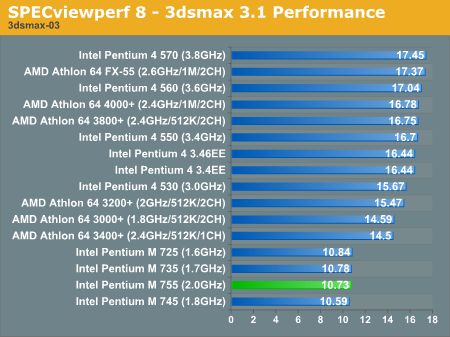
CATIA Viewset (catia-01)
"The catia-01 viewset was created from traces of the graphics workload generated by the CATIATM V5R12 application from Dassault Systems.
Three models are measured using various modes in CATIA. Phil Harris of LionHeart Solutions, developer of CATBench2003, supplied SPEC/GPC with the models used to measure the CATIA application. The models are courtesy of CATBench2003 and CATIA Community.
The car model contains more than two million points. SPECviewperf replicates the geometry represented by the smaller engine block and submarine models to increase complexity and decrease frame rates. After replication, these models contain 1.2 million vertices (engine block) and 1.8 million vertices (submarine).
State changes as made by the application are included throughout the rendering of the model, including matrix, material, light and line-stipple changes. All state changes are derived from a trace of the running application. The state changes put considerably more stress on graphics subsystems than the simple geometry dumps found in older SPECviewperf viewsets.
Mirroring the application, draw arrays are used for some tests and immediate mode used for others."
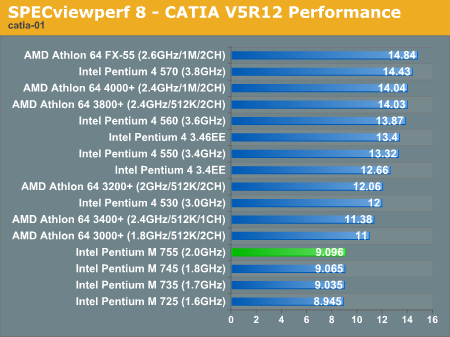
Lightscape Viewset (light-07)
"The light-07 viewset was created from traces of the graphics workload generated by the Lightscape Visualization System from Discreet Logic. Lightscape combines proprietary radiosity algorithms with a physically based lighting interface.
The most significant feature of Lightscape is its ability to simulate global illumination effects accurately by precalculating the diffuse energy distribution in an environment and storing the lighting distribution as part of the 3D model. The resulting lighting "mesh" can then be rapidly displayed."
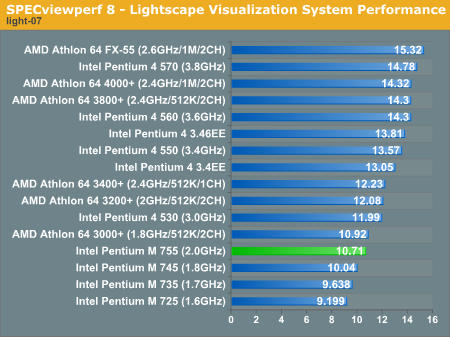
Maya Viewset (maya-01)
"The maya-01 viewset was created from traces of the graphics workload generated by the Maya V5 application from Alias.
The models used in the tests were contributed by artists at NVIDIA. Various modes in the Maya application are measured.
State changes as made by the application are included throughout the rendering of the model, including matrix, material, light and line-stipple changes. All state changes are derived from a trace of the running application. The state changes put considerably more stress on graphics subsystems than the simple geometry dumps found in older viewsets.
As in the Maya V5 application, array element is used to transfer data through the OpenGL API."
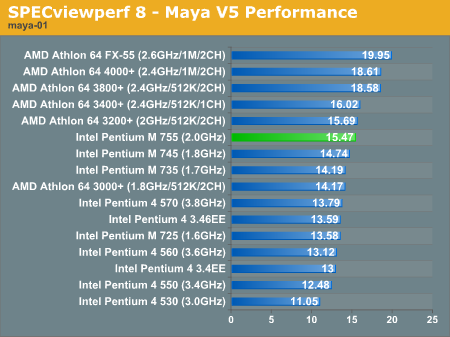
Pro/ENGINEER (proe-03)
"The proe-03 viewset was created from traces of the graphics workload generated by the Pro/ENGINEER 2001TM application from PTC.
Two models and three rendering modes are measured during the test. PTC contributed the models to SPEC for use in measurement of the Pro/ENGINEER application. The first of the models, the PTC World Car, represents a large-model workload composed of 3.9 to 5.9 million vertices. This model is measured in shaded, hidden-line removal, and wireframe modes. The wireframe workloads are measured both in normal and antialiased mode. The second model is a copier. It is a medium-sized model made up of 485,000 to 1.6 million vertices. Shaded and hidden-line-removal modes were measured for this model.
This viewset includes state changes as made by the application throughout the rendering of the model, including matrix, material, light and line-stipple changes. The PTC World Car shaded frames include more than 100MB of state and vertex information per frame. All state changes are derived from a trace of the running application. The state changes put considerably more stress on graphics subsystems than the simple geometry dumps found in older viewsets.
Mirroring the application, draw arrays are used for the shaded tests and immediate mode is used for the wireframe. The gradient background used by the Pro/E application is also included to better model the application workload."

SolidWorks Viewset (sw-01)
"The sw-01 viewset was created from traces of the graphics workload generated by the Solidworks 2004 application from Dassault Systemes.
The model and workloads used were contributed by Solidworks as part of the SPECapc for SolidWorks 2004 benchmark.
State changes as made by the application are included throughout the rendering of the model, including matrix, material, light and line-stipple changes. All state changes are derived from a trace of the running application. The state changes put considerably more stress on graphics subsystems than the simple geometry dumps found in older viewsets.
Mirroring the application, draw arrays are used for some tests and immediate mode used for others."

Unigraphics (ugs-04)
"The ugs-04 viewset was created from traces of the graphics workload generated by Unigraphics V17.
The engine model used was taken from the SPECapc for Unigraphics V17 application benchmark. Three rendering modes are measured -- shaded, shaded with transparency, and wireframe. The wireframe workloads are measured both in normal and anti-alised mode. All tests are repeated twice, rotating once in the center of the screen and then moving about the frame to measure clipping performance.
The viewset is based on a trace of the running application and includes all the state changes found during normal Unigraphics operation. As with the application, OpenGL display lists are used to transfer data to the graphics subsystem. Thousands of display lists of varying sizes go into generating each frame of the model.
To increase model size and complexity, SPECviewperf 8.0 replicates the model two times more than the previous ugs-03 test."
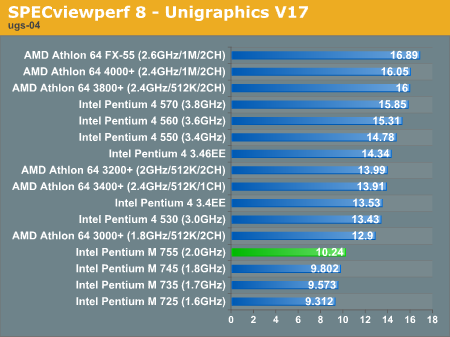










77 Comments
View All Comments
bobsmith1492 - Monday, February 7, 2005 - link
Granted the T8000 here is an Intel fanboy, but please notice Anand was comparing clock-for-clock.T8000 - Monday, February 7, 2005 - link
There is one big difference between this review and the reviews where the Pentium M did very well: CLOCKSPEED!While others where able to get over 2.8 Ghz with aircooling, Anand got just 2.4 Ghz. This may be a coincidence, but it is the difference between surprisingly good performance and a few % below others.
As most of the benchmarks where based on the stock 2 Ghz, the difference became even greater.
So this review just shows that the stock speed Pentium M performs about 30% less with about 30% less clockspeed than overclocked versions.
A slightly redesigned version with higher voltages is not extremely unlikely to hit at least 3 Ghz. Combining that with a desktop chipset will result in stellar performance, as the benchmark scores in this review (x1.5) indicate.
But since there is no slightly redesigned version and Intel has no good reason to make one, the current Pentium M desktops will only appeal to overclockers and silent computing people.
Also, for some reason, Anand found the 90W TDP of the 2.4 Ghz A64 closer to the 20W of the P-M than to the 110W of the 3.8 Ghz P4.
CSMR - Monday, February 7, 2005 - link
That's a very good option Zebo, thanks for posting it.teutonicknight - Monday, February 7, 2005 - link
One suggestion: Why don't you start using a newer version of Premiere for testing? I personally don't use it, but every that I know who does says before Premiere Pro, the program sucked. I'm sure the render results would be much more realistic and accurate if you used a more up to date version of the programRegs - Monday, February 7, 2005 - link
I was wondering the same thing too Jeff. If you feed it more bandwidth, it would eliminate the pipeline stalls and maybe give it a chance to reach higher clock speeds. Right? Or is it still prohibited by the shorter pipeline to reach higher clock speeds?Longer pipeline = wasted clock cycles. But to me that sounds like the PM should actually scale a lot better with a speed boost. Why exactly does it scale badly compared to a P4? Could it be remedied in anyway with a dual channel memory bus?
ozzimark - Monday, February 7, 2005 - link
there's something wrong with the 3400+ in the spec tests. why is the 3000+ beating it consitantly?Warder45 - Monday, February 7, 2005 - link
Maybe I missed something but I don't see the reason for all the negitivity in the final words. The 2.4Ghz P-M was very close to the A64 2.4Ghz in many of the tests, 3D rendering seemed to slow it down but that looked like it. With better boards and memory the P-M might best the A64 in a clock for clock match up.I do agree the prices are way too high. I think Intel really needs to wake up and smell what they have cooking here. With more support and more aggressive priceing they could easily have a winner in the HTPC and SFF markets.
plewis00 - Monday, February 7, 2005 - link
Surely when someone builds a mainboard with the Sonoma (i915) platform using PCI-E and DDR2-533 then it will change. And I wouldn't have thought that's that far off assuming they don't charge rip-off prices for the technology. It would also be perfect for Shuttle systems where the emphasis is on quietness and coolness rather than so much on performance.Zebo - Monday, February 7, 2005 - link
CSMRSo's this one very soon..
http://www.xtremesystems.org/forums/showthread.php...
...more than excellent performance wise if Dothan is excellent...power differential hopefully for AMD will be nominal.
Sokaku - Monday, February 7, 2005 - link
While it is true that the A64 has way more bandwidth, I doubt that is the reason why it crushed the P-M in the Professional Applications. I think the real cause is to be found in the P-M's abillity to do FP divisions. The P-III had a pipelined FP unit, however div operations were extremly expensive. My guess would be that Intel haven't thrown much effort into improving on this.